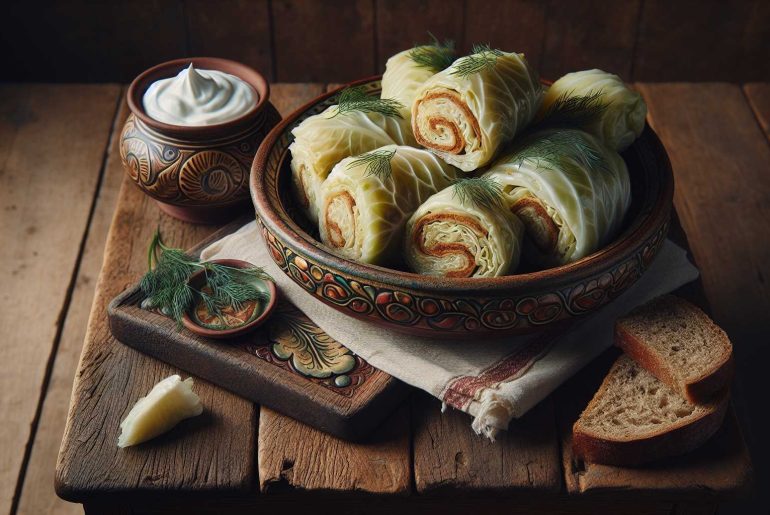
Stuffed cabbage rolls, or Gołąbki, hold a special place in Polish food culture. This dish combines meat, rice, and spices wrapped in soft cabbage leaves and is a key example of Polish culinary creativity.
It’s interesting to look into how Gołąbki became such an important part of Polish meals. By exploring its history, we see how carefully chosen ingredients and local variations make each version unique. This tells us a lot about the rich food traditions in Poland.
The Origins of Gołąbki
Gołąbki, a traditional Polish dish, has its roots in Poland’s rich culinary history. The name ‘Gołąbki’ means ‘little pigeons’ in Polish, humorously referring to the shape of these cabbage rolls rather than their ingredients. This name reflects the playful side of Polish culture. Gołąbki is more than just food; it’s a symbol of comfort and family. It’s hard to pinpoint exactly when Gołąbki became a staple in Poland, as it shares its heritage with the broader Eastern European region. However, its particular way of being prepared with local ingredients marks it as distinctively Polish.
Over the years, Gołąbki has shown remarkable versatility, adapting to both times of plenty and scarcity. This adaptability speaks volumes about Poland’s history and its people’s resilience. For example, the filling of Gołąbki can vary, using different meats, grains, or vegetables, depending on availability. This flexibility makes Gołąbki a testament to Polish creativity in the kitchen.
To really understand the importance of Gołąbki, consider how it’s made. The process involves wrapping a mix of meat and rice in cabbage leaves, then cooking them in a tomato-based sauce. Each step, from the choice of filling to the final sauce, can be customized. This adaptability not only showcases the ingenuity of Polish cooking but also allows Gołąbki to remain a beloved dish through changing times and tastes.
In conversation, Gołąbki is often mentioned with a sense of nostalgia, reminding people of home and family gatherings. Its enduring presence in Polish cuisine highlights its role not just as a meal, but as a cultural touchstone, connecting generations. For those looking to explore Polish cooking, trying your hand at making Gołąbki is a great start. It’s a delicious way to dive into Poland’s culinary heritage and experience the warmth and hospitality that Polish food embodies.
Selecting the Perfect Ingredients
Selecting the right ingredients is key to making traditional Gołąbki, a favorite Polish dish. The core of the recipe is cabbage. Choose fresh, green cabbage with leaves that are soft and flexible, making them easier to wrap around the filling. The filling typically consists of ground pork or a mix of pork and beef. This combination offers the classic taste that makes Gołąbki so loved. Add finely chopped onions to the mix for a hint of sweetness and garlic for a richer flavor.
For texture and to help the filling bind together, incorporate high-quality, raw rice. It will soak up all the delicious flavors as it cooks. Seasoning is straightforward but crucial. Salt and pepper are basics, but adding marjoram or thyme brings out the best in the meats and rice.
Using fresh, quality ingredients is not just about sticking to tradition. It’s about creating a dish that truly represents Polish culinary heritage. When shopping for ingredients, consider visiting a local butcher for the meat to ensure freshness. For the rice, opt for a brand that is known for its quality, as this can make a difference in how well it cooks and absorbs flavors.
Step-by-Step Cooking Process
After picking the best ingredients, you’ll start making Gołąbki by getting the cabbage leaves ready. You’ll do this by boiling the whole cabbage until its leaves are flexible enough to fold without breaking. When the leaves are soft, cool them down, and then cut away the thick vein in the middle so they cook evenly and have the right texture.
Next, you’ll prepare the filling, which is a tasty mix of ground meat, rice, onions, and spices. Mix these ingredients well. Then, take a portion of this mixture and place it on a cabbage leaf. Roll the leaf so it forms a tight package around the filling. Place these rolls in a deep pot, layering them with sauce or broth, and then let them simmer. This cooking process allows the flavors to mix together perfectly.
When boiling the cabbage, a helpful tip is to insert a fork into the core and gently pull the leaves off as they soften. This technique helps in keeping the leaves intact. For the filling, using a mix of beef and pork can enhance the flavor, but you’re free to choose based on your preference. If you’re looking for a sauce recommendation, a simple tomato sauce seasoned with garlic, salt, and a bit of sugar can complement the rolls nicely.
Remember, the goal is to make sure the Gołąbki are cooked thoroughly, so the meat is well-done, and the flavors are well-blended. Cooking on a low simmer for about 1 to 1.5 hours usually does the trick. Serving them hot with a dollop of sour cream or a sprinkle of fresh herbs can add an extra layer of flavor.
Serving and Presentation Tips
After you’ve nailed down the art of cooking Gołąbki, the next step is to present and serve them in a way that elevates the entire dining experience. Typically, you’d arrange these stuffed cabbage rolls on a serving dish with the seam facing downward. This not only keeps them intact but also ensures they look inviting. To add an extra touch of elegance and flavor, consider placing a dollop of sour cream on each roll or lightly drizzling it over the top. This provides a beautiful contrast and introduces a creamy texture that pairs perfectly with the dish.
For a pop of color and a hint of freshness, sprinkle some fresh herbs like dill or parsley over the Gołąbki. This simple addition can transform the presentation and add depth to the flavor profile. Complementing the rolls with a side of creamy mashed potatoes or a crisp light salad rounds off the meal, creating a well-balanced and visually appealing plate.
Variations Across Regions
Gołąbki, a popular dish in Polish cuisine, showcases a variety of preparations across Poland, each reflecting the unique flavors and ingredients of the region. For example, in the southern highlands, chefs often combine pork and beef, adding smoked bacon for depth of flavor. This choice reflects the region’s preference for hearty, meaty dishes. On the other hand, along the coast, the recipe might change to include local fish or mushrooms, taking advantage of the fresh seafood and forest resources available there.
In the heart of Poland, a more classic version prevails, focusing on a simple yet satisfying filling of rice and meat, seasoned with herbs that grow locally. This traditional method highlights the importance of using ingredients that are readily available, ensuring the dish is both fresh and flavorful.
The variations in Gołąbki preparation across Poland’s regions not only demonstrate the adaptability of this beloved dish but also paint a picture of the country’s diverse culinary landscape. Each version tells a story of local preferences, traditions, and agricultural practices, making Gołąbki a perfect example of how food can connect us to a particular place and its culture.
For anyone interested in exploring Polish cuisine, trying different regional variations of Gołąbki offers a delicious way to understand the country’s rich culinary heritage. Whether it’s the meaty versions from the highlands, the seafood or mushroom-filled creations from the coast, or the classic rice and meat combination from central Poland, each variant provides a unique taste experience.
Conclusion
Stuffed cabbage rolls, or Gołąbki, are a classic Polish dish that holds a special place in the country’s food culture. This dish, made with carefully chosen ingredients and a specific cooking method, shows the rich cultural influences in Poland.
Each region has its own twist on the recipe, proving how popular and versatile Gołąbki is. When prepared and served with attention to detail, these cabbage rolls capture the true flavor of Polish cuisine, making them a favorite among many.







Comments are closed.